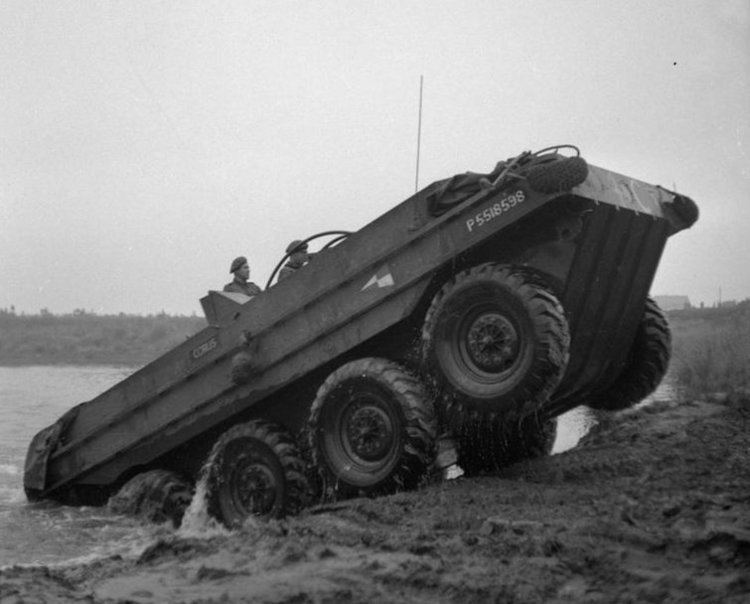Place of origin United Kingdom No. built 200 | Produced 1943–1944 (Mark I) | |
 | ||
Type Armoured personnel carrier | ||
The Terrapin "4-ton amphibian" was a British-manufactured, amphibious armoured transport vehicle of the Second World War. It was first used in 1944 at Antwerp during the Battle of the Scheldt.
Contents
Terrapins served with the Royal Engineer assault teams of the 79th Armoured Division and were used to carry infantry units (Canadian and British) over rivers.
Development
Due to a shortage of US-manufactured DUKWs, the British Ministry of Supply commissioned Thornycroft to design an amphibious vehicle capable of ferrying supplies and troops from ship to shore for the D-Day landings.
Some 500 Terrapin Mark 1 were built by Morris Commercial, the commercial vehicle side of Morris Motors Limited.
A Mark 2 Terrapin with a number of improvements reached the prototype stage, but the war ended before it entered production.
Mark 1
The Terrapin was powered by two Ford V8 engines mounted side-by-side, with each motor driving the wheels on one side. Wheel braking was used to steer, the brakes being operated by levers.
On a level surface, the vehicle was supported on the four middle wheels, the front and rear wheels remaining clear of the surface (the front pair being raised significantly, the rear pair only slightly). The front and rear wheels provided support and traction on soft surfaces and when climbing slopes, such as riverbanks. When driven in the water, it was propelled by two rear-mounted propellers.
Despite success in its first military action, the Terrapin was not overall a successful design and had many significant defects, which were never overcome in service.
Due to the large diameter tyres, the Terrapin was a relatively high vehicle and, although open-topped, it was difficult to enter and exit. Any soldier attempting to exit over the side faced both prolonged exposure to enemy fire and possible injury from the fall.
Like the Medium Mark A Whippet tank of the First World War, the Terrapin had separate engines driving each side of the vehicle with skid steering. This arrangement was awkward on the Whippet, and on the Terrapin as well. If one engine broke down, the Terrapin tended to swing around violently.
The two centrally located engines split the cargo compartment in two and, though rated as a 4-ton vehicle, this prevented large loads, such as heavy artillery or vehicles, from being carried. In addition, the driver had poor visibility as he was centrally located inside the middle of the vehicle. This was compounded by the installation of a canvas cover over the forward hold. As a result, another crew member typically had to stand behind the driver and provide directions.
In use, the vehicle was found to be rather slow, and was easily swamped in rough seas. The specification had limited the length to 23 feet (7.0 m) and this made its seagoing characteristics inferior to the American DUKW.
These failings quickly led to the abandonment of the design in favour of the development of the Mark 2, but the growing availability of large numbers of the much more successful DUKW made further development unnecessary.
Mark II
This was similar to the Mark 1, but had a forward driving position. It was a much longer vehicle, being 31 feet (9.4 m) long compared with the 23 feet (7.0 m) length of the Mark I.
Only five of these 5-ton capacity vehicles were built.
Use
During the operations against Walcheren, Terrapins and Buffalo transports carried the 9th Canadian Infantry Brigade in what was intended to be a diversionary attack across a mile wide inlet on 9 October 1944. A sufficiently large bridgehead was made that the attack became the main attempt and the German defences were turned.
Terrapins were used in Operation Vitality II on 26 October to carry units from the British 52nd (Lowland) Division across the Scheldt; Amphibious Sherman DD tanks led the attack.
Survivors
Kevin Wheatcroft, owner of The Wheatcroft Collection in Great Britain, is known as being the owner of an unrestored Terrapin Mk1. John Belfield, a collector in Australia, also owns a Terrapin wreck, which still carries the original Australian Registration Number (ARN) 149391.
